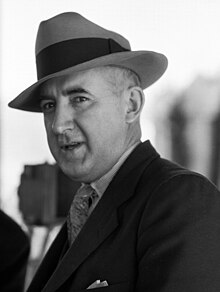Raymond Moley
Raymond Moley | |
|---|---|
 Moley in 1933 | |
| Born | Raymond Charles Moley September 27, 1886 Berea, Ohio |
| Died | February 18, 1975 (age 88) Phoenix, Arizona |
| Occupation | Presidential adviser, professor of law, author |
| Nationality | American |
Raymond Charles Moley (September 27, 1886 – February 18, 1975) was an American political economist.[not verified in body] Initially a leading supporter of the New Deal, he went on to become its bitter opponent before the end of the Great Depression.
Early life and career

The son of Felix James and Agnes Fairchild Moley,
Advisor to FDR
Moley supported then-
Move to the right
In mid-1933 Moley began his break with Roosevelt, and although he continued to write speeches for the president until 1936, he became increasingly critical of his policies, eventually becoming a
Moley was awarded the Presidential Medal of Freedom by Richard Nixon on April 22, 1970.[7]
Publications
He wrote several books including:
- Lessons in Democracy (1919)
- Commercial Recreation (1919)
- Facts for Future Citizens (1922)
- After Seven Years (1939; online e-book)
- The Hays Office (1944)
- How to Keep Our Liberty (1952; online e-book)
- The First New Deal (1966)
References
- ^ Moley, Raymond. Encyclopedia of Cleveland History. 1997 Jul 21. Retrieved 2008-10-15.
- ^ Shlaes, Amity, The Forgotten Man: A New History of the Great Depression, Harper Collins, 2007.
- ^ Three phonotapes of interviews of Raymond Moley, 1970, relating to Franklin D. Roosevelt and The First New Deal and Moley's diary; Raymond Moley papers; Audio-Visual file; Hoover Institution Archives.
- ^ Moley, Raymond. "After Seven Years". Harper & Brothers Publishers, 1939, p. 155.
- ^ Chamberlain, John, A Life With the Printed Word, Regnery, 1982, p.138; Agnew, Jean-Christophe, and Rosenzweig, Roy, A Companion to Post-1945 America, Blackwell, 2002, p.309.
- ^ Esposito, David and Jackie (September 1988). "LaGuardia and the Nazis". American Jewish History. 78 (1): 38-53: 42.
- ^ Nixon, Richard (April 22, 1970). "Remarks on Presenting the Presidential Medal of Freedom to Eight Journalists". Online by Gerhard Peters and John T. Woolley, The American Presidency Project. Archived from the original on 2011-10-01. Retrieved 2011-12-25.
- This article incorporates text from a publication now in the New International Encyclopedia (1st ed.). New York: Dodd, Mead.)
{{cite encyclopedia}}: Missing or empty|title=(help
Further reading
- Wells, Rob. The Insider: How the Kiplinger Newsletter Bridged Washington and Wall Street (U of Massachusetts Press, 2022) online review of this book; Moley secretly provided inside news about New Deal plans to the widely read newsletter.
